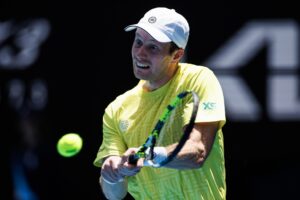After wandering around the Aegon Open Nottingham site I found myself coming to a halt between two courts. On one court a men’s singles match. Thomas Fabbiano against Yuki Bhambri, embroiled in a tense first set battle. On the other court a ladies doubles match. Ashley Weinhold and Caitlin Whoriskey against Casey Dellacqua and Hao-Ching Chan.
I stood for a little while, enjoying the tennis and flitting my attention between both courts equally. After a couple of minutes I began to realise that I had lost interest in the singles and was almost exclusively watching the doubles.
Then from next to me I heard a lady – whose name I later discovered was Ruth – utter the words that made me consider writing this piece. “Doubles is actually really fun. We should definitely watch it more often. I wonder why people don’t watch it?”. I wrote this down in my notepad so I wouldn’t forget it for one simple reason. Ruth was right. Doubles is very fun – which begs the question why doesn’t it receive more attention?
I decided to have a chat with Ruth and her friend about the doubles and what she was enjoying about it. Growing up I had often gone to the Royal Albert Hall for the Champions Tour event and watched the likes of Mansour Bahrami and Henri Leconte orchestrate the crowd with their delightful doubles showmanship. My love of doubles has been embedded within me for a long time.
Mansour Bahrami at his best #AusOpen pic.twitter.com/aRPx2t4Duj
— #AusOpen (@AustralianOpen) January 21, 2017
Ruth however, said she’d never really watched it. She played a little bit of doubles herself but had usually only watched the “famous people” play singles. The net-play, she said, was a particular highlight, especially from someone who played a little herself. The fun factor was a big part as well – she liked that the players looked like they were enjoying themselves and weren’t “breaking rackets all over the place”.
Is tennis doubles serious or exhibition tennis?
That is exactly where I’ve decided the strengths and weaknesses of doubles are. It is, more often than not, effectively exhibition tennis. Four players, rather than two, automatically makes it a more relaxed and less intense environment. Certainly when watching it live, this increases enjoyment for the fans. Smiles and laughter are contagious and this is far more common in doubles than in singles.
The fun factor is also a contributor to doubles’ downfall though. Fun is all well and good, especially live, but at at the end of the day sport’s uniting principle is the element of competition. Tennis is a sport whose popularity is dependent on intense battles and with that element lacking in doubles this is where it loses its interest.
There was something else that Ruth said that piqued my interest and that was about watching “famous people” play singles. With the greatest of respect to Bhambri and Fabbiano, neither are particularly famous names, especially to your average British fan like Ruth. Add on top that both are baseline campers with nothing to particularly distinguish either of their games. If it had been Roger Federer and Rafael Nadal playing then I would have little doubt that Ruth – and my attention too for that matter – would not have been on the doubles.
Roger Federer: 6,000 fans turn up to watch Perth practice https://t.co/bru8vMYUTZ pic.twitter.com/cKAkFhFKJX
— ㅤㅤㅤㅤㅤㅤㅤㅤㅤㅤㅤㅤㅤㅤㅤㅤㅤㅤㅤㅤ (@asmui_ahmad) December 30, 2016
That highlights an inevitable limitation for doubles. It simply does not have the star power. The big names that casual tennis fans love are all almost exclusively singles players. Apart from Davis Cup, Fed Cup and perhaps the likes of Indian Wells and Miami, it is rare to see tennis’ big crowd pleasers grace the doubles court. In December, thousands upon thousands turned out to see Roger Federer play a training session. Would that have been the same case if it had been John Peers and Henri Kontinen, or Bethanie Mattek-Sands and Lucie Safarova? Absolutely not.
Television networks do not care about doubles, so why should you?
Doubles is furthered hindered by both television and order of plays. Simply put, television networks rarely show it. And sadly, it is understandable. Because people do not watch doubles on television, why on earth would they waste airtime on it? Tennis TV made a big point about promoting doubles at Indian Wells and Miami but that is because all of the big ATP names were playing and that was their commercial selling point.
Order of plays will also almost always consign doubles matches to the tennis wasteland that is the outside courts. To use Nottingham as an example, the only times any doubles matches have been scheduled is when one of the major British players are competing, and even then it has been scheduled last so has been moved to an outside court more often than not.
I enjoyed chatting with Ruth but I very much doubt that she’ll honestly start watching regularly. Not because I don’t believe that she is enthusiastic about doubles and has good intentions, but because to follow doubles regularly requires a lot of hard work. It’s fun to watch live but incredibly tough to watch on television or online. Add on to that the fact that its another mountain of names to learn in a sport where it’s already hard enough to keep track of every singles player.
Doubles is a lot of fun, there is little doubting that. Anyone who has had the opportunity to watch it live will tell you that. The very nature of doubles play means that there are simply more ‘highlight reel’ rallies. Yet that does not always translate to television, and the lack of household names will always be a hindrance. I think, as much as many of us love doubles, we have to accept that it was always be on the periphery of tennis circles.
Main Photo:






